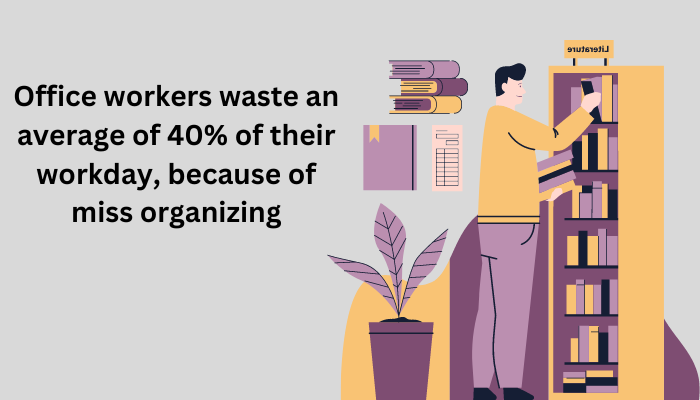Organizing is a process that allows organizations to achieve its goals by working effectively. What is the best definition of organizing? It establishes the relationship between the workplace and people to work together for a common goal.
What is the best definition of Organizing?
The best definition of organizing is arranging and coordinating human and material resources to ensure the best implementation of plans and the achievement of goals. As a result, organizing builds an organizational structure in which tasks, relationships, and authorities are clearly defined.
After the definition, in this article, we will discuss the meanings, characteristics, and all-important aspects of organizing in detail.
💡 Helpful Statistics About Organizing:
● Office workers waste an average of 40% of their workday, becouse of miss organizing.
● Organizing reduce stress, 80% of our medical expenditures are stress related as stated by The Centers for Disease Control and
Prevention.
● An enterprise employing 1,000 knowledge workers wastes $48,000 per week, or nearly $2.5M per year, due to an inability to locate and
retrieve information. (courtesy of napo.net).
● 50% of homeowners rate their garage as the most disorganized room in the house, yet the most frequently used by family members
96% of office workers are frustrated by their company’s information management, Harte-Hanks
● According to Forbes ASAP, the typical executive today wastes 150 hours a year, almost one month, searching for lost information. For
someone earning $50,000 a year, that translates to a loss of $3,842
● Typical US worker is interrupted by communications technology every 10 minutes, Institute for Future and Gallup
● 80% of papers and information that we keep, we never use, Agency Sales Magazine.
● Email is increasing print volume by 40%, Document Magazine

Table of Contents
Explanation of the Best Definition of Organizing
Now we will find out some more details about our topic. First, revise the definition of organizing for better understanding.
Organizing is the process of arranging and coordinating human and material resources to ensure the best implementation of plans and the achievement of goals. As a result, organizing builds an organizational structure in which tasks, relationships, and authorities are clearly defined.
One other precise definition of organizing is the business activities that involve the distribution of planned work among the employees and assembling resources for the successful working of the business.
Moreover, organizing is a driving force in the success of an organization. It also works on building relationships among the employees, the work, and their workplace. In other words, it is a business activity that provides all the principal elements required for daily operations, such as suitable employees, raw materials, and other resources.
Let’s break that down:
From the definition, we extract four significant functions of organizing.
- Arranging and coordinating human and material resources
- Ensures implementation of plans
- Achievement of goals
- Builds the organization structure

Let’s discuss each point in detail for better understanding.
Arranging and coordinating human and material resources
Two types of organizational resources are mandatory for organizational success. These resources include human resources and material resources. Human resources include knowledgeable employees and skilled workers etc. On the other hand, material resources include tools, machinery, building, etc.
To present a plan or a project organizations need human and material resources. Organizing ensures that suitable and expert people join the project and necessary material resources are provided if available; if not, they are arranged.
The coordination of both will help progress the project. Without coordination, the project can face multiple bottlenecks. Organizing builds relationships among various assets for the smooth running of work. Moreover, it helps in Arranging and coordinating human and material resources to achieve the goal.
Coordination between human and material resources ensures the effective utilization of firm resources, leading to organizational success.
Human resource plays a vital role in organizational success. The managers develop the relationship between the top management and subordinates for the smooth running of departments and units.
All decisions about the individual’s rights, responsibilities, roles, and assignment of tasks lie with the organizers. Moreover, there are various methods to distribute organizational tasks.
Therefore, with the proper arrangement and coordination of material and human resources, the organizers ensure the organization performs its day-to-day functions effectively.
The practical and efficient use of organizing functions is only possible through coordinating human and material resources.
Ensures implementation of plans
Organizing ensures the implementation of plans. The managers identify the necessary activities, classify them, and distribute them among the employees. Identifying activities is the first step before performing them, and it helps achieve organizational goals. Examples of business activities are quality control and generating sales.
After the identification of organizational activities, managers group these into workable departments. In other words, combining and grouping similar activities are the responsibilities of the Organizing function. For example, the managers can work on departmentalization by dividing the whole concern into units and departments.
Achievement Of Goals
The organizing function enables the organization to achieve its goals. To accomplish the organizational objectives, organizers work on making policies, plans, rules, and regulations for supervisors to follow. It is the making of organizational structure.
The top management is responsible for making the rules and policies for the organization. Besides, top-level management communicates the duties to the subordinates to perform their tasks fully and help attain the organizational goals.
Moreover, this allows the team to know where the authority lies. The successful making of plans and their implementation is the work of organizers that help the firm to achieve its goals.
Organizing Builds an organizational structure
Organizing builds an organizational structure that clearly defines tasks, responsibilities, and authorities. Organizational structure deals with the distribution of authorities and duties among the relevant workforces.
Distribution of Responsibilities:
The distribution of responsibilities is the task of organizing. After determining the organizational activities, the next mission in organizing is to assign duties to subordinate managers. In addition, the top-level managers give various ranks among individuals according to their characteristics and qualifications.
The responsibility of making policies and rules lies with the top-level managers. At the same time, the supervision of departments is the responsibility of the middle managers. Besides, overseeing the lower workforce is the responsibility of low-level management.
The division of authority among various levels of management helps run the firm successfully. Furthermore, it is quite helpful in avoiding the wastage of organizational resources.
Furthermore, there would not be any ambiguity if the rules and responsibilities of the organizational structure is well-defined. Therefore, it enables organizations to perform their tasks on time.
Relationship Among Departments
One project is divided into multiple tasks, and each job is assigned to its related department. Different departments work together to accomplish the goal. For example, when a new product is launched, various department work together to make it happen. R&D, marketing, production, sales, and quality control departments work hand-in-hand.
Organizing function ensures that all departments are coordinated and have flawless communication to avoid conflicts.
Delegation of authority
The managers develop the relationship between the top management and subordinates for the smooth running of departments and units. The top management is responsible for making the rules and policies for the organization.
Additionally, top-level management communicates the duties to the associates, so they can perform their tasks fully and help attain the organizational goals. Moreover, this allows the team to know to whom they can report and answerable to.
Everyone can’t report back to the CEO, so the organizing function ensures delegation of authority. Different people are answerable to other heads or managers.
Why is this definition considered the best definition of organizing?
The definition we discussed is considered the best definition of organizing because this is easy to understand, simple, and covers all aspects of the organizing process. Moreover, this definition gives us information about the methods and activities of the firm.
The organizers use quite a few methods to organize the employees. Inside the firm, the employees are responsible for executing the activities assigned to them by their supervisors.
Organizing combines all the firm tools, such as machines, buildings, fixed assets, and human resources, including workers’ knowledge and skills for organizational success.
Some examples of other definitions of organizing
Some examples of other definitions of organizing are that it is a managerial process that combines organizational resources and human efforts effectively and efficiently to accomplish a common goal.
In other words, it is the effective use of firm resources to achieve the desired goals. Moreover, it is organizing the firm resources that contribute to the success of an organization.
Organizing is the function of management concerned with the designing of firm structure. This function helps the business allocate human assets to achieve the desired goals.
Organizing organizes the distribution of responsibilities and authorities among all the departments for the successful implementation of plans.
The sole purpose of organizing is to ensure that the firm’s daily operations are smoothly running so that the organization achieves its goals. Moreover, the effective and efficient utilization of resources is the goal of organizers.
Conclusion
Organizing is the process of arranging and coordinating human and material resources to ensure the best implementation of plans and the achievement of goals. As a result, organizing builds an organizational structure in which tasks, relationships, and authorities are clearly defined.
One other precise definition of organizing is the business activities that involve the distribution of planned work among the employees and assembling resources for the successful working of the business. Read our article Why organizing is important to know its practical implications.
Moreover, organizing is a driving force in the success of an organization. Furthermore, it also works on building relationships among the employees, the work, and their workplace. It is a business activity that provides all the vital elements required for daily operations, such as suitable employees, raw materials, and other resources.
In other words, it is about implementing and executing plans for organizational success by defining job descriptions and creating a healthy work environment.


